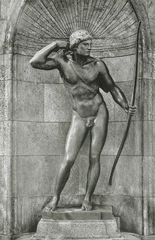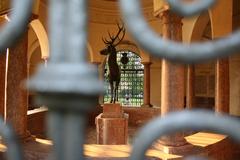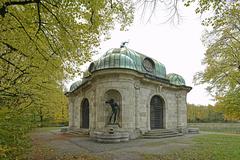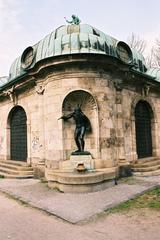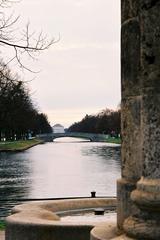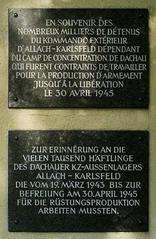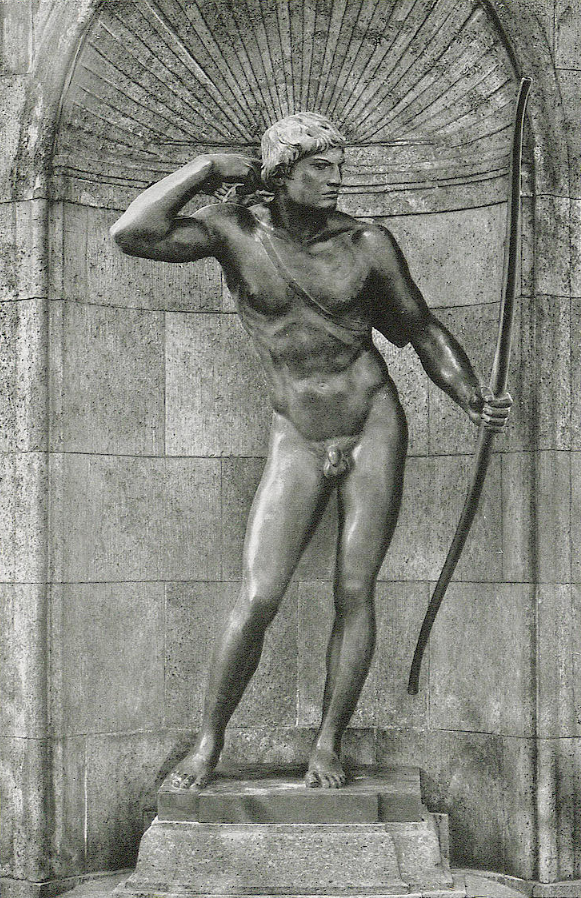
Visiting Hubertusbrunnen: Hours, Tickets, and Historical Insights
Date: 31/07/2024
Introduction
Nestled in the vibrant city of Munich, Germany, the Hubertusbrunnen, or Hubertus Fountain, stands as a remarkable testament to the city’s rich historical and cultural heritage. Designed by the acclaimed sculptor Adolf von Hildebrand between 1906 and 1921, this neoclassical masterpiece was initially situated in the courtyard of the Wittelsbach family’s former hunting lodge. The fountain’s intricate design, featuring Saint Hubertus and the legendary stag bearing a crucifix between its antlers, captures the essence of the aristocratic and hunting traditions of the era (Google Arts & Culture).
The fountain has endured a turbulent history, including its dismantling during the Nazi regime in 1937 and subsequent reconstruction on Wisenhausstraße in 1954. This resilience mirrors Munich’s collective effort to restore and preserve its cultural landmarks in the aftermath of World War II. Today, the Hubertusbrunnen not only serves as a striking piece of public art but also as a cherished gathering spot that reflects the city’s ability to blend its historical legacy with contemporary urban life (Munich Travel).
Visitors to the Hubertusbrunnen are treated to a visual spectacle that combines art, history, and nature. The surrounding area is rich with attractions such as the Nymphenburg Palace, the Hirschgarten, and several notable museums, making it a perfect destination for those looking to immerse themselves in Munich’s cultural offerings. With no entrance fee and open access 24/7, the fountain is an ideal stop for both budget-conscious travelers and history enthusiasts alike (Absolute Munich).
Table of Contents
Hubertusbrunnen in Munich: Visiting Hours, Tickets, and Historical Significance
Origins and Historical Context
The Hubertusbrunnen, also known as the Hubertus Fountain, is a significant historical monument located in Munich, Germany. The fountain was originally designed by the renowned sculptor Adolf von Hildebrand between 1906 and 1921. Hildebrand, a prominent figure in the art world, was known for his classical style and his contributions to public art in Germany. The fountain was initially installed in the courtyard of the former hunting lodge of the Wittelsbach family, reflecting the aristocratic and hunting traditions of the time.
The Hubertusbrunnen was dismantled in 1937 during the Nazi regime, a period marked by significant political and social upheaval. The fountain was later rebuilt on Wisenhausstraße in 1954, post-World War II, as part of the efforts to restore Munich’s cultural heritage. This relocation and reconstruction symbolize the resilience and dedication of the Munich community to preserve its historical landmarks (Google Arts & Culture).
Architectural and Artistic Features
The Hubertusbrunnen is a masterpiece of early 20th-century sculpture, embodying the neoclassical style that Adolf von Hildebrand was famous for. The fountain features a central figure of Saint Hubertus, the patron saint of hunters, who is depicted in a moment of divine revelation with a stag bearing a crucifix between its antlers. This imagery is rooted in the legend of Saint Hubertus, who converted to Christianity after encountering the miraculous stag during a hunt.
The fountain’s design includes intricate details and motifs that celebrate nature and hunting, such as the lifelike representations of animals and foliage. The use of bronze and stone in the construction of the fountain adds to its grandeur and durability, making it a lasting tribute to Munich’s artistic heritage (Google Arts & Culture).
Cultural and Social Significance
The Hubertusbrunnen holds a special place in Munich’s cultural landscape. It serves as a reminder of the city’s rich history and its connection to the Wittelsbach dynasty, who were avid hunters and patrons of the arts. The fountain’s relocation and restoration in the mid-20th century highlight the community’s commitment to preserving its cultural identity amidst the challenges of post-war reconstruction.
The fountain is not only a historical monument but also a popular gathering spot for locals and tourists alike. Its serene setting and artistic beauty make it a favored location for relaxation and reflection, contributing to the social fabric of the city. The Hubertusbrunnen is a testament to Munich’s ability to blend its historical legacy with contemporary urban life (Munich Travel).
Visitor Tips and Practical Information
For those planning to visit the Hubertusbrunnen, here are some practical tips to enhance your experience:
- Location: The fountain is situated on Wisenhausstraße, easily accessible by public transportation. Visitors can take the U-Bahn or tram to nearby stops and enjoy a short walk to the site.
- Best Time to Visit: The fountain is open to the public year-round, but the best time to visit is during the spring and summer months when the surrounding greenery is in full bloom, providing a picturesque backdrop.
- Nearby Attractions: The Hubertusbrunnen is located near several other notable attractions in Munich, including the Nymphenburg Palace and the Botanical Garden. Visitors can plan a day trip to explore these sites and enjoy the natural beauty and historical significance of the area (Munich Travel).
- Photography: The fountain’s intricate details and serene setting make it an excellent subject for photography. Early morning or late afternoon light provides the best conditions for capturing its beauty.
- Guided Tours: For those interested in a deeper understanding of the fountain’s history and significance, guided tours are available. These tours often include visits to other historical landmarks in the area, providing a comprehensive overview of Munich’s cultural heritage.
- Visiting Hours and Tickets: The Hubertusbrunnen is accessible 24/7, and there are no ticket fees to visit the fountain. Admission is free, making it an ideal stop for budget-conscious travelers.
Preservation and Maintenance
The preservation of the Hubertusbrunnen is a collaborative effort between the city of Munich and various cultural organizations. Regular maintenance ensures that the fountain remains in excellent condition, allowing future generations to appreciate its historical and artistic value. The city’s commitment to preserving its cultural landmarks is evident in the meticulous care given to the Hubertusbrunnen and other historical sites.
Efforts to promote awareness and appreciation of the fountain include educational programs and cultural events. These initiatives aim to engage the community and visitors in the rich history and artistic heritage of Munich, fostering a sense of pride and stewardship for the city’s cultural assets (Munich Travel).
Annual Events and Special Features
The Hubertusbrunnen is often included in annual cultural events and festivals in Munich. These events can include historical reenactments, guided tours, and art exhibitions that highlight the fountain’s significance and the legend of Saint Hubertus. Participating in these events offers a unique opportunity to experience the fountain in a lively and educational context.
FAQ Section
What are the visiting hours for Hubertusbrunnen? The Hubertusbrunnen is accessible 24 hours a day, 7 days a week.
How much are the tickets for Hubertusbrunnen? There are no tickets required to visit the Hubertusbrunnen; admission is free.
Where is Hubertusbrunnen located? The fountain is located on Wisenhausstraße in Munich, Germany.
What is the best time to visit Hubertusbrunnen? The best time to visit is during the spring and summer months when the surrounding greenery is in full bloom.
Are there any special events at Hubertusbrunnen? Yes, the fountain is often included in annual cultural events and festivals in Munich, which may include historical reenactments and guided tours.
Conclusion
The Hubertusbrunnen is more than just a fountain; it is a symbol of Munich’s historical and cultural legacy. Its artistic beauty, historical significance, and social relevance make it a must-visit destination for anyone exploring the city. By understanding its origins, appreciating its artistic features, and recognizing its cultural impact, visitors can gain a deeper appreciation for this remarkable monument and the city it represents (Google Arts & Culture, Munich Travel, Absolute Munich).
Map to Hubertusbrunnen
Stay updated with the latest information by following us on social media and checking out our mobile app Audiala for more travel tips and guides.
References
- Google Arts & Culture, 2024, Hubertusbrunnen Fountain
- Munich Travel, 2024, Stadtteil Neuhausen Nymphenburg
- Absolute Munich, 2024, Hubertusbrunnen Munich Fountain
